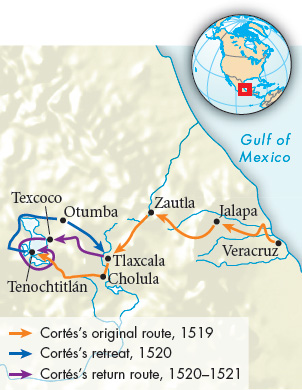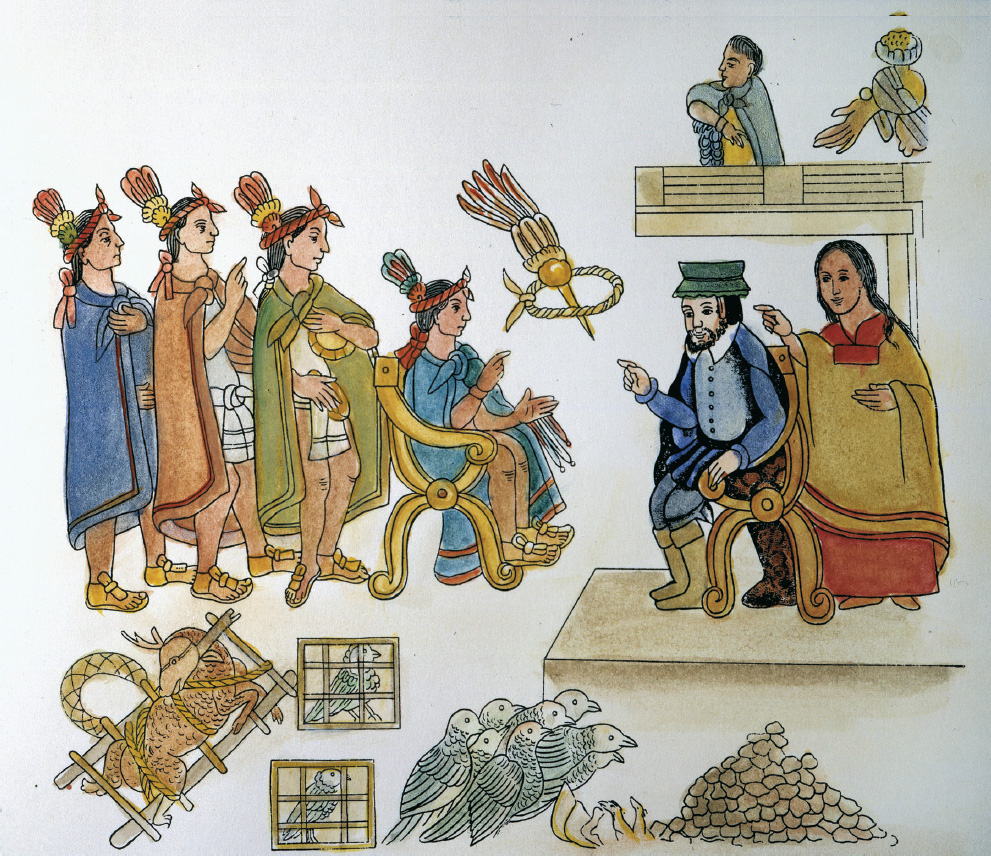Spanish Conquest in the New World
conquistador Spanish for “conqueror”; Spanish soldier-explorer, such as Hernando Cortés and Francisco Pizarro, who sought to conquer the New World for the Spanish crown.
Mexica Empire Also known as the Aztec Empire, a large and complex Native American civilization in modern Mexico and Central America that possessed advanced mathematical, astronomical, and engineering technology.
After Columbus’s voyages Spanish explorers penetrated farther into the New World. This territorial expansion began in 1519, when the Spanish governor in Cuba sent an expedition, under the command of the conquistador (kahn-KEES-tuh-dor) Hernando Cortés (1485–1547), to what is now Mexico. Accompanied by six hundred men, sixteen horses, and ten cannon, Cortés was to launch the conquest of the Mexica Empire. Its people were later called the Aztecs, but now most scholars prefer to use the term Mexica to refer to them and their empire.
The Mexica Empire was ruled by Montezuma II (r. 1502–1520) from his capital at Tenochtitlán (tay-nawch-teet-LAHN), now Mexico City. Larger than any European city of the time, it was the heart of a sophisticated, advanced civilization.
Soon after Cortés landed on the Mexican coast on April 21, 1519, his camp was visited by delegations of Mexica leaders bearing gifts and news of their great emperor. Impressed by the wealth of the local people, Cortés decided to defy his orders from the governor in Cuba, which restricted him to trading and exploration, and set up a settlement, Veracruz, under his own authority. He then burned his ships to prevent any disloyal or frightened followers from returning to Cuba.

The Mexica state religion necessitated constant warfare against neighboring peoples to secure captives for religious sacrifices and laborers for agricultural and building projects. Conquered peoples were required to pay tribute to the Mexica state through their local chiefs. Realizing that he could exploit dissension over this practice to his own advantage, Cortés forged an alliance with the Tlaxcala (tlah-SKAH-lah) and other subject kingdoms. In October a combined Spanish-Tlaxcalan force occupied the city of Cholula and massacred many thousand inhabitants. Strengthened by this display of power, Cortés made alliances with other native kingdoms. In November 1519, with a few hundred Spanish men and some six thousand indigenous warriors, he marched on Tenochtitlán.

Montezuma refrained from attacking the Spaniards as they advanced toward his capital and welcomed Cortés and his men into Tenochtitlán. Other native leaders attacked the Spanish, but Montezuma relied on the advice of his state council, itself divided, and on the dubious loyalty of tribute-paying communities subjugated by the Mexica. Montezuma’s long hesitation proved disastrous. When Cortés took Montezuma hostage, the emperor’s influence over his people crumbled.
Inca Empire The vast and sophisticated Peruvian empire centered at the capital city of Cuzco that was at its peak from 1438 until 1532.
During the ensuing attacks and counterattacks, Montezuma was killed. The Spaniards and their allies escaped from the city and began gathering forces and making new alliances against the Mexica. In May 1510 Cortés led a second, much larger assault on Tenochtitlán. The Spanish victory in late summer 1521 was hard-won and greatly aided by the effects of smallpox, which had weakened and reduced the Mexica population. After the defeat of Tenochtitlán, Cortés and other conquistadors began the systematic conquest of Mexico. Over time a series of indigenous kingdoms fell under Spanish domination, although not without decades of resistance.
More surprising than the defeat of the Mexicas was the fall of the remote Inca Empire in Peru. Like the Mexicas, they had created a vast empire that rivaled that of the Europeans in population and complexity. However, by the time of the Spanish invasion the Inca Empire had been weakened by a civil war over succession and an epidemic of disease, possibly smallpox.
The Spanish conquistador Francisco Pizarro (ca. 1475–1541) landed on the northern coast of Peru on May 13, 1532, the very day Atahualpa (ah-tuh-WAHL-puh) won control of the empire after five years of fighting his brother for the throne. As Pizarro advanced across the Andes toward Cuzco, the capital of the Inca Empire, Atahualpa was also heading there for his coronation.
Quick Review
How did previous knowledge of and experience with the Afroeurasian trade system shape European expansion in the fifteenth and early sixteenth centuries?
Atahualpa sent envoys to greet the Spanish and invite them to meet him in the provincial town of Cajamarca. His plan was to lure the Spaniards into a trap, seize their horses and ablest men for his army, and execute the rest. Instead, the Spaniards ambushed and captured him, collected an enormous ransom in gold, and then executed him in 1533. The Spanish then marched on to Cuzco, profiting once again from internal conflicts to form alliances with local peoples. When Cuzco fell in 1533, the Spanish plundered immense riches in gold and silver.
As with the Mexica, decades of violence and resistance followed the defeat of the Incan capital. Nevertheless, the Spanish conquest opened a new chapter in European relations with the New World. It was not long before rival European nations attempted to forge their own overseas empires.